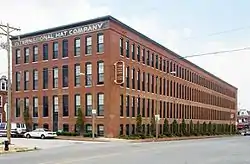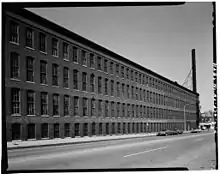Brown Shoe Company's Homes-Take Factory
Brown Shoe Company's Homes-Take Factory, also known as the International Hat Company Warehouse, is a historic building location at 1201 Russell Boulevard in the Soulard neighborhood of St. Louis, Missouri.[5] Built in 1904, by renowned architect Albert B. Groves, the building was originally a factory for the Brown Shoe Company, based in St. Louis.[4][6] In 1954, the factory was subsequently converted into a warehouse by the International Hat Company.[4] The site has been recognized as a testament to Grove's architectural expertise in the principles of factory design, namely technical advances in layout planning, operational efficiency, and employee safety.[2] Additionally, the factory epitomizes the early 20th century cultural transformation and socio-industrial development of St. Louis into a manufacturing powerhouse. In particular, the Brown Shoe Company is recognized as a principal player in challenging the 19th century dominance of the New England shoe industry.[7] This significantly contributed to the early 20th century sobriquet of St. Louis as the city of "shoes, booze, and blues."[8] The Brown Shoe Company's Homes-Take factory is considered to be among the pioneering industrial facilities of this historic transformation.[2]
Brown Shoe Company's Homes-Take Factory | |
 Brown Shoe Company Factory (1904-1930s) and International Hat Company Warehouse (1954-1976).[1] Since 1980, the building operates as a senior and disabled living facility. | |
   | |
| Location | 1201 Russell Boulevard St. Louis, Missouri |
|---|---|
| Coordinates | 38°36′29″N 90°12′36″W |
| Built | 1904[2] |
| Architect | Albert B. Groves[3][4] |
| NRHP reference No. | 80004503 |
| Designated NRHP | October 20, 1980[3] |
History

The Homes-Take factory was designed and constructed in 1904 by the noted St. Louis architect Albert B. Groves (1866-1925). The Brown Shoe Company paid $66,000 for the construction project, which with inflation would cost over $1,700,000 in 2015.[2] Groves designed and built eighteen churches in St. Louis, as well as a myriad of commercial, residential, and industrial buildings.[2] In particular, Groves developed eleven factories for the Brown Shoe Company.[2] The Homes-Take factory began production with a medium-priced line of women's dress shoes.[4]
During the Great Depression, the factory was permanently mothballed.[4] In 1954, the property was bought by the International Hat Company, which converted the factory into a warehouse.[4] The Mexican Hat factory purchased a separate part of the building and converted the section into office space.[2] The International Hat warehouse operated until 1976.[4] That same year, the entire building was sold to the Junior Achievement of the Mississippi Valley.[2] In 1978, the building was bought by Allen Market Lane Apartments.[4] According to historian M. M. Constanin, the area at the time appeared as a sort of "Brechtian gloom," insofar as the abandoned building and street created a sense of alienation and detachment from the once vibrant and purposeful area.[9]
On October 20, 1980, the building was formally added to the National Register of Historic Places after being petitioned by Allen Market Lane Apartments.[3][10] Since 1980, the property has operated as a senior and disabled living center, with 100 units.[4] The apartment complex was thoroughly renovated in 2005.
Architecture
The Homes-Take factory was originally designed to be a four-story, rectangular red brick building, measuring sixty by three hundred feet.[2] The building occupies approximately one half of a city block.[2] A dominant feature of the architectural design is the closely spaced windows, ten feet by three-and-a-half feet.[2] As part of the restoration of the building, Allen Market Lane Apartments installed historically-correct, single hung Quaker windows.[10] In 2005, the windows were custom designed to preserve the original aesthetic quality and structural integrity of the original 1904 glass work.[2] Preserving the windows was a necessary element of the process of obtaining and maintaining government approval of the building onto the National Register of Historic Places.
See also
References
- Heitz 2016, p. 69.
- Missouri State Government (1975) National Register of Historic Places, Nomination Form. Retrieved March 10, 2016.
- National Register of Historical Places (2016) Brown Shoe Company's Homes-Take Factory United States Federal Park Services. Retrieved March 15, 2016
- Fox 1995, p. 54.
- Clayton History Society (2008) "Brown Shoe Company". Retrieved March 15, 2016.
- "Shoe and Leather Encyclopedia". Shoe and Leather Gazette. St. Louis: Tradesmen's Publishing Group: 50. 1911. Retrieved 12 October 2016.
- Sawyer, I. H. (12 January 1910). "How St. Louis Became the Greatest Shoe Center". St. Louis: Tradesmen's Publishing Company. Shoe and Leather Gazette. pp. 29–30.
- Gratz and Mintz 2000, p. 318.
- Constanin 1978, p. 69.
- Windows and Doors: Historical Series (PDF). Freeburg, MO: Quaker. 2015. p. 11. Archived from the original (PDF) on 17 August 2016. Retrieved 9 October 2016.
Bibliography
- Constanin, M. M. (1978). Sidestreets St. Louis. Pennsylvania State University: Sidestreets Press.
- Fox, Tim (1995). Where We Live: A Guide to St. Louis Communities. St. Louis, MO: Missouri Historical Society Pr. ISBN 188398212X. Retrieved 12 October 2016.
- Gratz, Roberta Brandes; Mintz, Norman (2000). Cities Back from the Edge: New Life for Downtown. Hoboken, NJ: John Wiley & Sons. ISBN 9780471361244. Retrieved 12 October 2016.
- Heitz, Jesse (2016). Fire Resistance in American Heavy Timber Construction: History and Preservation. New York, NY: Springer Publishing. ISBN 9783319321288. Retrieved 12 October 2016.
External links
- Planning and Urban Design Agency Homes-Take Factory becomes the model example for 2016 multi-story apartment building in Soulard neighborhood.